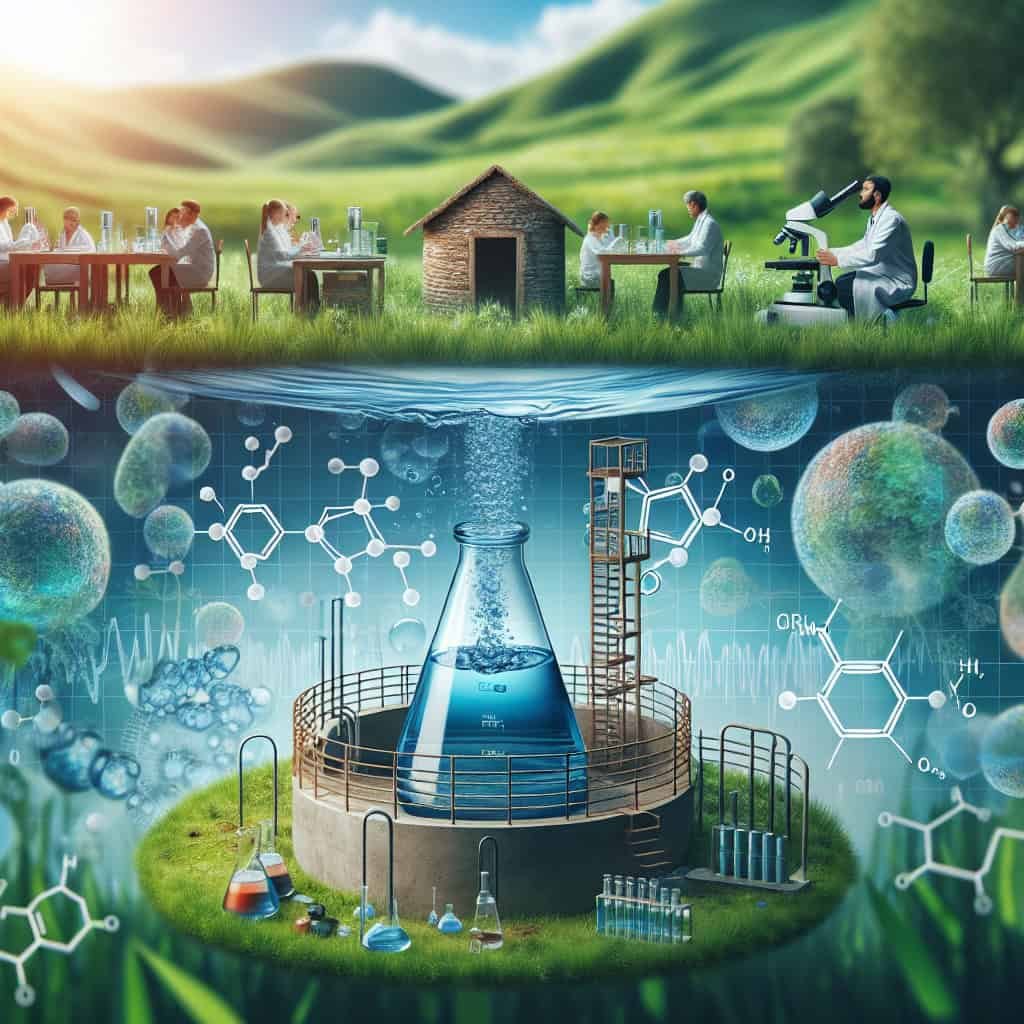In today’s rapidly changing environment, ensuring the safety and purity of our water sources has become increasingly important. With emerging contaminants posing potential risks, it is crucial to stay informed about the recommended well water quality tests. By understanding which tests are essential, you can confidently take proactive measures to safeguard your well water and protect the health of yourself and your loved ones.
I. Introduction
Ensuring the quality of your well water is crucial for maintaining your health and the well-being of the environment. With the rise of emerging contaminants, it becomes even more important to regularly test your well water. In this article, we will explore the definition and types of emerging contaminants, discuss the potential risks they pose, and emphasize the significance of testing well water for these contaminants. We will also provide recommendations on the different types of tests you should consider, outline the basic water quality parameters to check, and elaborate on targeted tests for specific contaminants. Additionally, we will delve into comprehensive water testing methods and discuss the factors to consider when choosing a testing lab. Finally, we will guide you on how to interpret test results and take appropriate action based on those results.
II. Understanding Emerging Contaminants
A. Definition and Types of Emerging Contaminants
Emerging contaminants are substances that have recently been discovered in water sources but are not yet regulated or well-understood. These contaminants can come from various sources including agricultural runoff, industrial activities, pharmaceuticals, personal care products, and household chemicals. Examples of emerging contaminants include perfluorinated compounds (PFCs), pharmaceuticals, pesticides, endocrine-disrupting compounds, and microplastics.
B. Sources and Potential Risks of Emerging Contaminants
Emerging contaminants can enter water sources through various pathways such as improper disposal, leakage from storage tanks, or through irrigation and drainage systems. Once in the water, these contaminants can have adverse effects on human health and the environment. They may lead to hormonal disruptions, reproductive issues, antibiotic resistance, and ecological imbalances. It is crucial to identify and mitigate these risks through regular testing and appropriate actions.

III. Importance of Testing Well Water for Emerging Contaminants
A. Potential Health Risks
Testing well water for emerging contaminants is essential to safeguard the health of you and your family. Most emerging contaminants, even in low concentrations, can have long-term health effects, especially if consumed over an extended period. For example, exposure to heavy metals like lead, arsenic, or mercury can lead to neurological disorders, developmental delays, and organ damage. By testing your well water, you can identify and address potential risks before they cause harm.
B. Environmental Concerns
Emerging contaminants not only pose risks to human health but also have significant implications for the environment. Contaminants like pharmaceuticals, pesticides, and endocrine-disrupting compounds can persist in the water and harm aquatic organisms, leading to the disruption of ecosystems. By testing your well water, you contribute to the overall protection and conservation of the environment.
C. Regulatory Compliance
While emerging contaminants may not yet be regulated, it is essential to stay ahead of potential regulations. By proactively testing your well water for these contaminants, you demonstrate a commitment to environmental stewardship and ensure compliance with future regulatory requirements. Additionally, some states or municipalities may have guidelines or recommendations regarding well water testing for emerging contaminants, making it even more crucial to stay informed and take appropriate action.
IV. Recommended Well Water Quality Tests
A. Basic Water Quality Parameters
To start assessing the overall quality of your well water, it is important to conduct tests for basic water quality parameters. These parameters give you a general understanding of the water’s composition and can help identify potential issues. Key basic parameters to test include pH level, Total Dissolved Solids (TDS), chlorine residual, turbidity, conductivity, hardness, and alkalinity.
B. Targeted Tests for Specific Contaminants
In addition to basic water quality parameters, it is crucial to conduct targeted tests for specific contaminants commonly found in well water. These contaminants may vary depending on your region and potential pollution sources. Key targeted tests include heavy metals such as lead, arsenic, and mercury; nitrates and nitrites; volatile organic compounds (VOCs); pesticides and herbicides; pharmaceuticals and personal care products (PPCPs); endocrine-disrupting compounds (EDCs); and microorganisms such as bacteria and viruses.
C. Comprehensive Water Testing
For a more thorough analysis of your well water, comprehensive water testing is recommended. This includes conducting emerging contaminant screening, inorganic and organic compound analysis, microbiological analysis, isotope analysis, and long-term monitoring. Comprehensive water testing provides a comprehensive understanding of the contaminants present, enabling you to take appropriate action to address any issues that may arise.

V. Basic Water Quality Parameters
A. pH Level
The pH level of your well water indicates its acidity or alkalinity. A pH between 6.5 and 8.5 is generally considered safe for drinking water. Values outside this range may indicate potential problems with the water source or contamination. Acidic water can corrode pipes while alkaline water may cause mineral deposits. Additionally, extremely high or low pH levels can affect the taste of the water.
B. Total Dissolved Solids (TDS)
TDS refers to the overall concentration of dissolved substances in the water, including minerals, salts, and other organic and inorganic compounds. Elevated TDS levels may indicate potential contamination sources or excessive mineral content. While some minerals are essential, excessively high TDS levels may affect the taste, smell, and even the health of the water.
C. Chlorine Residual
Chlorine residual is an important parameter to test, especially if your water supply is chlorinated or treated with chlorine-based disinfectants. Chlorine is widely used in water treatment processes to kill harmful microorganisms. However, excessive chlorine levels can have negative health effects. Testing chlorine residual ensures that the disinfection process is effective and that the residual chlorine levels are within safe limits.
D. Turbidity
Turbidity refers to the cloudiness or haziness of water caused by suspended particles. High turbidity levels can indicate sediment runoff or inadequate filtration. While not directly harmful, high turbidity can affect the taste, odor, and appearance of the water. It can also interfere with disinfection processes, reducing their effectiveness.
E. Conductivity
Conductivity measures the ability of water to conduct electrical currents and indicates the presence of dissolved salts and minerals. High conductivity levels may suggest the presence of contaminants or excessive mineral content, which can affect the water’s taste and overall quality. Conductivity testing provides valuable insights into the overall composition of the water source.
F. Hardness
Water hardness refers to the concentration of minerals, primarily calcium and magnesium, in the water. While not directly harmful to health, hard water can cause issues such as scaling in pipes, reduced soap effectiveness, and adverse effects on appliances and fixtures. Testing water hardness allows you to identify potential issues and take appropriate action, such as water softening treatments, if needed.
G. Alkalinity
Alkalinity is related to the water’s ability to resist changes in pH. It indicates the presence of carbonate, bicarbonate, and hydroxide ions. Alkalinity testing is crucial for determining the water’s buffering capacity and its potential to neutralize acidic compounds. It helps ensure the water’s stability and ability to maintain a safe pH level, which is essential for various domestic and industrial uses.
VI. Targeted Tests for Specific Contaminants
A. Heavy Metals
Testing for heavy metals such as lead, arsenic, and mercury is crucial as they can have serious health effects even at low concentrations. These contaminants can enter the water supply through various sources, including industrial activities, mining, and natural deposits. Regular testing allows you to identify potential contamination and take immediate action to address any issues.
B. Nitrates and Nitrites
Nitrates and nitrites are commonly found in water sources contaminated by fertilizers, septic systems, or animal waste. High levels of nitrates and nitrites can be dangerous, particularly for infants and pregnant women, as they can cause methemoglobinemia (blue baby syndrome) and other health issues. Testing for nitrates and nitrites ensures the safety of your well water, especially if you live in an area with agricultural activities or proximity to livestock.
C. Volatile Organic Compounds (VOCs)
Volatile Organic Compounds (VOCs) are chemicals that can evaporate at room temperature and be present in well water sources. They can come from various sources, including gasoline, solvents, and industrial activities. Prolonged exposure to VOCs can have adverse health effects, including liver damage, kidney damage, and cancer. Regular testing for VOCs is crucial to assess the potential risks and take appropriate action to protect your health.
D. Pesticides and Herbicides
Well water sources near agricultural areas or residential landscapes treated with pesticides and herbicides are at risk of contamination by these chemicals. Prolonged exposure to pesticides and herbicides can lead to serious health issues, including neurological disorders, hormone disruption, and even cancer. Testing for these contaminants allows you to identify potential sources and take necessary steps to minimize exposure and protect your well water quality.
E. Pharmaceuticals and Personal Care Products (PPCPs)
Pharmaceuticals and personal care products (PPCPs), such as medications, hormones, and skincare products, can potentially enter water sources through various pathways, including improper disposal and wastewater treatment plant effluents. These compounds can have significant impacts on aquatic ecosystems and may pose health risks when consumed through drinking water. Testing for PPCPs ensures the safety of your well water and helps mitigate potential environmental and health concerns.
F. Endocrine Disrupting Compounds (EDCs)
Endocrine-disrupting compounds (EDCs) are substances that can interfere with the normal functioning of hormonal systems in both humans and wildlife. They can be found in various products, including plastics, cleaning agents, and personal care products. EDCs can have adverse effects on reproductive health, development, and immune function. Regular testing for EDCs is crucial to identify potential risks and take appropriate measures to protect your health and the environment.
G. Microorganisms
Testing for microorganisms, including bacteria, viruses, and parasites, is essential to ensure the safety of your well water. Contamination from sewage, animal waste, or inadequate well construction and maintenance can introduce harmful microorganisms into the water supply. Drinking water contaminated with microorganisms can cause severe gastrointestinal illnesses. Regular testing helps detect the presence of these pathogens and allows for the implementation of appropriate treatment or disinfection measures.

VII. Comprehensive Water Testing
A. Emerging Contaminant Screening
Comprehensive water testing includes emerging contaminant screening, which involves the analysis of a broad range of contaminants that may be present in your well water. This testing provides a comprehensive overview of the potential risks and identifies any emerging contaminants that may have previously gone undetected. This proactive approach is crucial for staying ahead of regulatory requirements and ensuring the safety of your well water.
B. Inorganic and Organic Compound Analysis
Inorganic and organic compound analysis aims to identify and quantify various compounds that may be present in your well water. This includes testing for heavy metals, pesticides, herbicides, volatile organic compounds, and other potentially harmful substances. By conducting this comprehensive analysis, you can have a detailed understanding of the composition of your well water and take appropriate actions to mitigate any risks.
C. Microbiological Analysis
Microbiological analysis focuses on identifying and quantifying microorganisms, including bacteria, viruses, and parasites, in your well water. This testing is crucial to ensure the absence of harmful pathogens and protect against waterborne diseases. By conducting regular microbiological analysis, you can take immediate action if any contamination is detected and ensure the ongoing safety of your well water.
D. Isotope Analysis
Isotope analysis provides valuable information about the origin and movement of certain contaminants in water sources. By analyzing the isotopic composition of specific elements or compounds, such as carbon, nitrogen, or chlorine, it becomes possible to trace the source of contamination, understand migration patterns, and assess the overall stability of your well water.
E. Long-Term Monitoring
Long-term monitoring involves regular and ongoing testing of your well water over an extended period. This approach is crucial for detecting any changes or trends in water quality and identifying potential emerging contaminants that may appear over time. Long-term monitoring allows for the implementation of preventive measures and prompt action to maintain the safety and quality of your well water.
VIII. Factors to Consider When Choosing Testing Labs
A. Accreditation and Certification
When selecting a testing lab, it is important to ensure that they are accredited and certified by reputable organizations. Accreditation ensures that the lab meets certain quality standards and follows standardized testing methodologies. Suitable accreditation bodies include the National Environmental Laboratory Accreditation Program (NELAP) and the International Organization for Standardization (ISO).
B. Expertise and Experience
Choose a testing lab with expertise and experience in well water analysis and emerging contaminants. Experienced labs understand the potential risks associated with emerging contaminants and can provide accurate and reliable results. Look for labs that have a proven track record in well water testing and offer specialized services for analyzing specific contaminants.
C. Testing Methodologies
Different testing labs may use different methodologies for analyzing contaminants. It is important to choose a lab that utilizes validated and reliable testing methods. Ensure that the lab employs state-of-the-art equipment and follows established procedures to ensure the accuracy and precision of their results.
D. Turnaround Time
Consider the turnaround time provided by the testing lab. The time required to receive test results may vary among different labs. It is important to choose a lab that can deliver results within a reasonable timeframe, allowing you to take prompt action based on the results.
E. Cost
The cost of testing services is an important factor to consider. While it is essential to prioritize the quality and reliability of the lab, it is also important to find a lab that offers competitive pricing. Compare the costs among different labs and consider the value you will receive in terms of accurate results and professional analysis.

IX. Interpreting Test Results
A. Comparison with Applicable Standards
When interpreting test results, it is crucial to compare them with applicable standards and guidelines. Regulatory agencies and health organizations provide guidelines and limits for various contaminants in drinking water. By comparing your test results with these standards, you can assess the level of contamination and understand whether any immediate action is required.
B. Consultation with Water Quality Experts
If you are unsure how to interpret the test results or are concerned about the potential risks, it is advisable to consult with water quality experts. Experts can provide valuable insights and guidance based on their knowledge and experience. They can help you understand the implications of the test results and recommend appropriate actions to address any potential issues.
X. Taking Action Based on Test Results
A. Water Treatment Options
Based on the test results, you may need to consider implementing water treatment options to address specific contaminants. Depending on the identified issues, treatment options can include filtration systems, reverse osmosis, activated carbon filters, or ultraviolet disinfection. Consulting with water treatment professionals can help you choose the most suitable treatment options for your specific needs.
B. Monitoring and Retesting
Monitoring and retesting your well water periodically are essential to ensure the effectiveness of implemented actions and the ongoing safety of your water supply. By monitoring water quality and retesting at regular intervals, you can detect any changes, identify emerging contaminants, and take appropriate measures to maintain the quality and safety of your well water.
C. Reporting and Compliance
If your well water testing reveals any contaminants that exceed applicable standards or guidelines, it may be necessary to report the findings to the appropriate authorities. Compliance with reporting requirements ensures that necessary actions are taken to protect public health and the environment. Be sure to follow any reporting guidelines specific to your region and consult with water quality experts or local authorities for guidance on compliance procedures.
In conclusion, testing well water for emerging contaminants is vital for maintaining good health and preserving the environment. By understanding the types and sources of emerging contaminants and conducting appropriate tests, you can identify and mitigate potential risks. Regular testing, utilizing both basic water quality parameters and targeted tests for specific contaminants, provides a comprehensive understanding of your well water quality. Choosing a reputable testing lab, interpreting test results accurately, and taking appropriate action based on those results ensure the ongoing safety and quality of your well water. Remember that prevention and proactive measures are key to protecting your health and the well-being of your environment.


